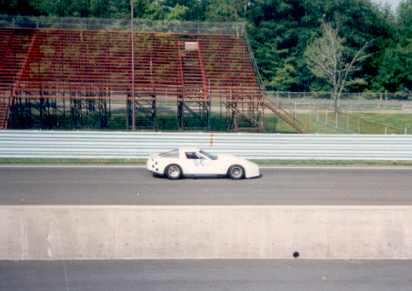Keith Parker began parkeracing in 1987 with the purchase of a 1971 LT-1 Corvette Coupe that was lightly modified for autocross use with the National Council of Corvette Clubs (NCCC).

Having owned at least one Corvette since age 19, and co-founding a Corvette club in 1983, Keith Parker began parkeracing in 1987 with the purchase of a 1971 LT-1 Corvette Coupe that was lightly modified for autocross use with the National Council of Corvette Clubs (NCCC). Those minor modifications pitted him against much more exotic equipment and put him in a dilemma of making many more non-stock changes to keep pace on a car that is relatively rare and valuable. Fate intervened with a spun bearing in the motor, so the decision was made to restore the car and get a dedicated track car.
That made way for the next car, a 1968 Corvette coupe with a tilt nose, fender flares, fuel cell, and roll cage purchased from a fellow competitor (both cars had competed in the same class previously). Beginning with drivers schools, HDPE‘s, and Time Trials, this cas was campaigned with NCCC (5th place overall, East Region, 1990), the Sports Car Club of America (SCCA, 1st place in class, South Jersey Region Solo II series 1989) and with the Eastern Motor Racing Association (EMRA, 2nd Place in class in the road racing series, 1990). This car was sold to make way for the move to GT-1 with the current car.


A career move to Florida saw a reuniting with a longtime Corvette friend who got the new car into fighting shape. After testing extensively before going to the debut race, The American Thundercar Racing Series all Corvette race at Sebring International Raceway, where the team came in second. Doing double duty that day, they were also in the GT-1 race later that day where an engine was lost after charging through the field. With a new motor in place, they returned to Sebring for the NCCC National Convention where the team came in first in class despite a balky shifter.
The car presently raced has a C4 Corvette body style being updated to 1996 body specs and making current with all the rules and technology permited in the class. This will be the cars second major rebuild/update. (See Original car tab to learn more of what we started with). Modifications include a dual MSD system, carbon fiber drive shaft and half shafts, rebuilding of the transmission and brake systems, upgrading to 16″ by 13″ wide wheels in back and 12″ wide wheels in front. Safety upgrades include, a new fuel cell, belts, helmet and a sprint car style net installed to the drivers right. By far, the most visible change will be the revised bodywork desinged to take advantage of current aero rules and give the car a twelve year facelift. A ’96 nose and tail section have been grafted on as well as side skirts on the doors and vent louvers in the hood. A splitter on the nose will be used to balance the down force of the carbon fiber wing. Everything will be finished in a Grand Sport paint scheme.


Future plans were to tune at NCCC hi-speed events, running for an EMRA GT-1 Championship, and doing some Pro events with the American GT (AGT) road racing association when they swing to a track nearby. The C4 got a major upgrade featuring a more radical engine from a Winston Cup team, rebuilt transmission, larger wheels, tires and brakes,redundant ignition systems.and 1996 bodywork with attention to aero. (see the rebuild here) It was this humble project that was the launch of Corvette Upgrade (see build here). Unfortunately, life gets in the way of the best laid plans and the car was sold without ever turning a wheel in the new configuration.

Fast forward a few years and we go back to the future with the debut of That 70’s Race Team featuring a 1977 wide body Corvette Coupe (see build here) and a 1980 Custom car hauler. It makes quite an impression wherever it runs. The long term goal is to run in the Optima Batteries Search for the Ultimate Street Car with local tune up events before going all in.
